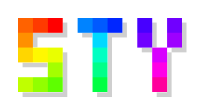

Release 1.0.0 (February 05. 2022)
Sty v1.0.0 released
At this point sty can be considered stable.
The "release candidate" phase was given a lot of time and nothing critical was reported for a while. All features that are planned for the future are compatible with the existing interfaces.
Nothing changed since rc.2.
Release 1.0.0-rc.2 (August 28. 2021)
- Fix typo in "reset" register.
Release Note (Breaking Changes)
Release 1.0.0-rc.1 (January 31. 2021)
- Sty is now fully typed.
- Deprecated methods .set_style(...) and .get_style(...) were finally removed.
Release 1.0.0-rc.0 (January 08. 2021)
Sty version 1.0.0 is now feature complete.
- I'm going to support Python version >=3.7 indefinitely.
- Sty will follow semver so there won't be any breaking changes for version 1.x.x after 1.0.0 was released.
- This is a pre-release (rc.0). I'll release 1.0.0 in a couple of month if no major bugs are reported.
Release Note (Breaking Changes)
Description
Sty's goal is to provide Python with a simple, customizable and performant string styling markup, which is decoupled from color palettes and terminal implementations.
- Sty supports 3/4bit, 8bit and 24bit (truecolor/RGB) colors as well as effects like bold, italic, underline, etc.
- Sty should work on most Unix platforms with most terminals. It works with recent Windows terminals. Window legacy terminal (cmd) needs a shim to work.
- Sty comes with default color palettes and renderers, but you can easily replace/customize them, without touching the markup in your code.
- Sty allows you to mute/unmute all styles in your codebase.
- Sty provides high access performance for all styling rules.
- Sty is fully typed, you should get good editor support for it.
- Sty does not implicitly mess with globals. E.g.: colorama overrides sys.stdout which causes a lot of trouble.
- Sty has no dependencies.
- Sty follows semver
- Sty will support Python >=3.7 for as long as possible.
If you run into compatibility problems with sty, please file an issue!
Code Example
from sty import fg, bg, ef, rs
foo = fg.red + 'This is red text!' + fg.rs
bar = bg.blue + 'This has a blue background!' + bg.rs
baz = ef.italic + 'This is italic text' + rs.italic
qux = fg(201) + 'This is pink text using 8bit colors' + fg.rs
qui = fg(255, 10, 10) + 'This is red text using 24bit colors.' + fg.rs
# Add custom colors:
from sty import Style, RgbFg
fg.orange = Style(RgbFg(255, 150, 50))
buf = fg.orange + 'Yay, Im orange.' + fg.rs
print(foo, bar, baz, qux, qui, buf, sep='\n')The code above will print like this in the terminal:

Documentation
Documentation-Website: https://sty.mewo.dev
Documentation-Website-Source: https://github.com/feluxe/sty-docs

